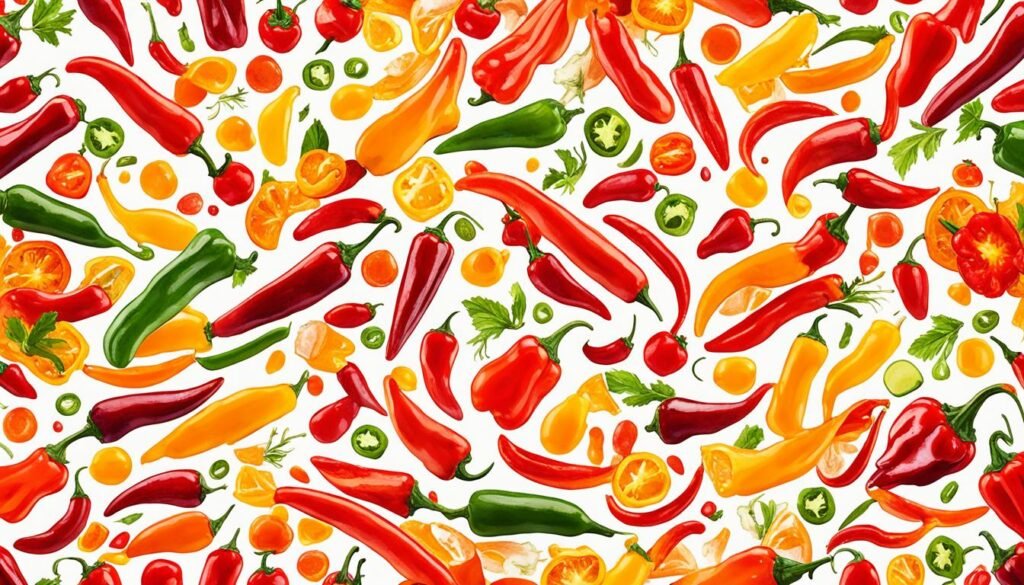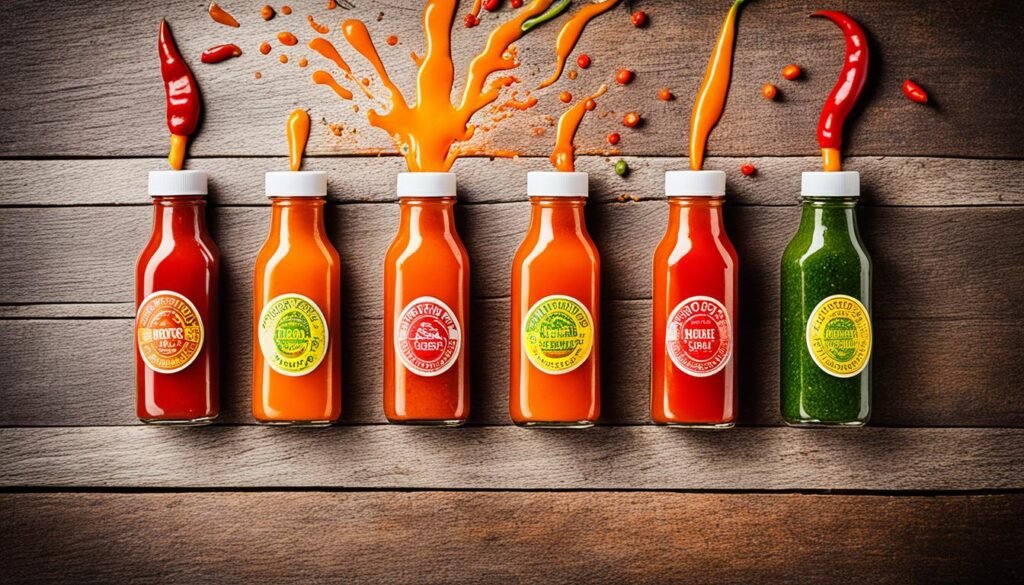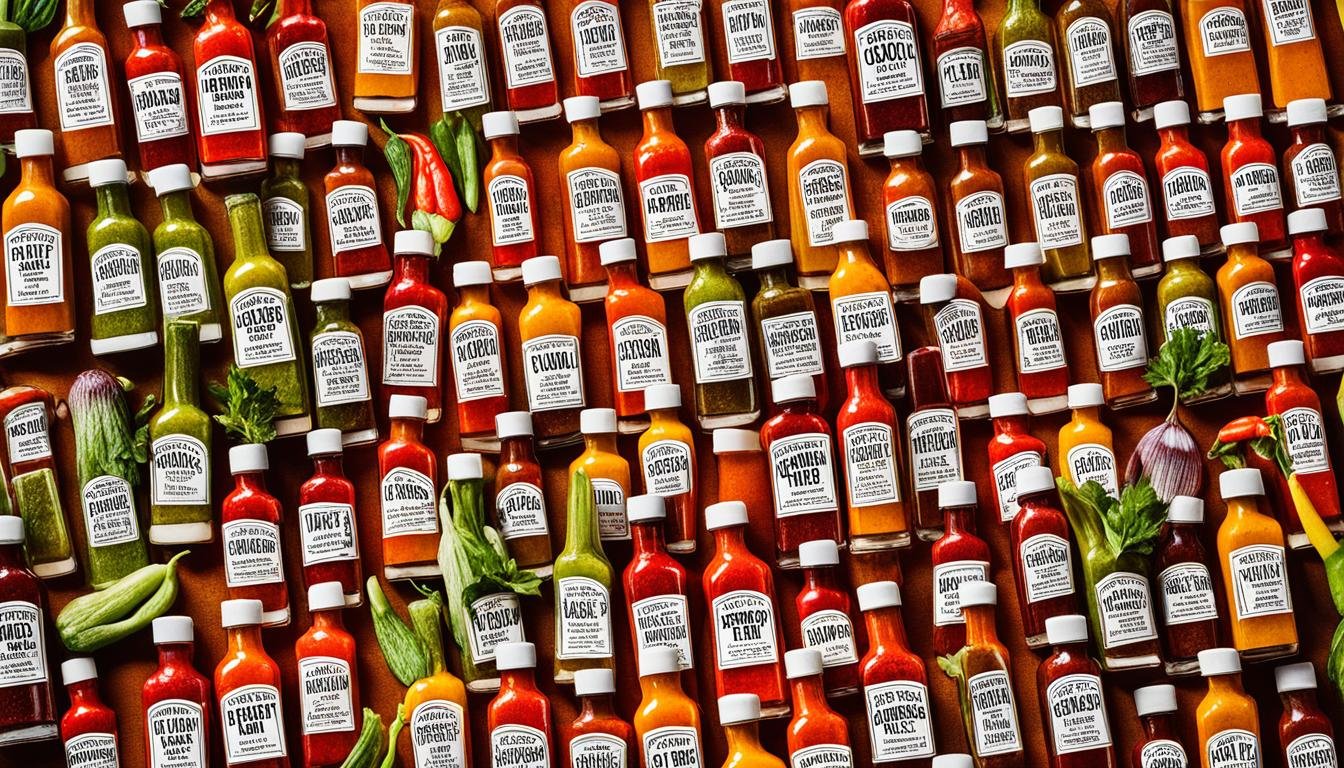Ready for a journey into the spiciest flavors around? This adventure will awaken your taste buds and take you to cultures keen on types of hot sauce. What started with chili peppers thousands of years ago is now a global feast of flavors. The SIANG JI ASIA SAUCE types of hot sauce story is about diversity and creativity in food.
Key Takeaways
- Discover the rich history and cultural significance of types of hot sauce around the world.
- Explore the science behind the Scoville Scale and understand the diverse heat levels of types of hot sauce.
- Learn about the unique flavor profiles and ingredients that contribute to the versatility of types of hot sauce.
- Dive into the art of hot sauce making and uncover the nuances of crafting artisanal types of hot sauce.
- Discover the potential health benefits and risks associated with the consumption of types of hot sauce.
The Flavorful Journey of Types of Hot Sauce
Hot sauce traces its roots back to the Americas. The chili pepper was key there. It not only brought the heat but also had healing powers. Europeans, thanks to the Columbian Exchange, spread these peppers worldwide. This started the diverse range of hot sauces we see today.
Through travels across continents, chili peppers became something special. They mixed with local spices everywhere, creating unique hot sauce flavors. For example, peri peri sauce from Africa uses African bird eye chilis. And Middle Eastern harissa has its distinct taste from smoked red peppers. This tale shows how hot sauce has crossed borders and captured hearts globally.
Exploring the Origins and Cultural Significance of Types of Hot Sauce
The story of hot sauce is closely tied to cultural history. In the Americas, chili peppers were more than just food. They were sacred, used in ceremonies and medicine. The Columbian Exchange sent these spices worldwide, starting a fiery global trend.
As hot sauce traveled, it became part of various cuisines worldwide. Mexico’s moles, Thailand’s sriracha, North Africa’s harissa – each tells a cultural story through its sauce. This shared love of spicy flavors unites people everywhere, from casual eats to fancy dining.
Hot sauce is adaptable and loved across cultures. It’s more than a condiment; it’s a way to share flavors and stories. Hot sauce, found everywhere from simple meals to fancy restaurants, brings people together. It celebrates our love for spice, innovation, and finding the perfect flavor balance.
“Hot sauce is more than just a condiment; it’s a cultural expression, a testament to the power of culinary fusion, and a celebration of the human desire to explore the boundaries of taste.”
Types of Hot Sauce – The Scoville Scale: Measuring the Heat
In the hot sauce world, the Scoville Scale is key. Wilbur Scoville created it. It measures chilli pepper heat in Scoville Heat Units (SHU). This scientific method helps us know how hot different hot sauces are.
The Scoville Scale goes from 0 SHU for mild bell peppers to over 2 million SHU for the Carolina Reaper. This range helps hot sauce lovers pick what suits them. The Scoville Scale is your map for finding the right amount of spice. Whether you like a little tingle or a major burn, this scale is your friend.
| Pepper Variety | Scoville Heat Units (SHU) |
|---|---|
| Bell Pepper | 0 SHU |
| Banana Pepper | 100-500 SHU |
| Anaheim Pepper | 500-2,500 SHU |
| Jalapeño Pepper | 2,500-8,000 SHU |
| Serrano Pepper | 6,000-23,000 SHU |
| Cayenne Pepper | 30,000-50,000 SHU |
| Habanero Pepper | 100,000-350,000 SHU |
| Ghost Pepper | 850,000-1,041,427 SHU |
| Carolina Reaper | 1,400,000-2,200,000 SHU |
The Scoville Scale helps all hot sauce fans. It lets you pick based on how spicy you like it. If you are new to spicy food or a hot sauce expert, knowing this scale will make your food journey exciting. It lets you appreciate types of hot sauce more.
“The Scoville Scale is the ultimate guide to navigating the world of spicy delights. It’s a game-changer for types of hot sauce enthusiasts who want to explore the full spectrum of heat.”
Spice Up Your World: Discovering the Versatility of Types of Hot Sauce
The world of types of hot sauce is full of variety and flavor. It doesn’t matter if you love the burn of habanero peppers or the tang of vinegar hot sauce variety, you’ll find something you like. We’ll look at a variety of hot sauce varieties, discussing their flavor profiles, ideal heat levels, and the best pairings.
Types of hot sauce from Mexico and the Caribbean offer bold, unique tastes. They take us on a culinary journey with their stories of creation and the cultures behind them.
Want to spice up your meals? Asia’s hot sauce varieties come with unique flavors like Thai chili’s sweet and sour. Or, try the deep, rich taste of Korean gochujang. These hot sauce varieties bring amazing flavors and heat to your dishes.
The variety in types of hot sauce is endless. From traditional American types to global fermented flavors, there’s a types of hot sauce for all tastes. It’s time to explore these bold condiments and add new flavors to your meals.
“Types of hot sauce can turn a plain dish into something amazing. A few drops bring a mix of flavor and heat that you’ll love.”
Types of Hot Sauce – Ingredients and Flavor Profiles
Every great hot sauce starts with a mix of ingredients that give it a special flavor. Chili peppers bring the heat, while vinegar adds a tang. Salt and spices are the secret to a bold taste. Together, they make a taste explosion.
The secret to most hot sauces is the chili pepper. From sweet bell peppers to spicy habaneros, they each bring a different heat and flavor. Picking the right mix of chili peppers is key to a great hot sauce.
Besides chili peppers, vinegar and salt are also key. Vinegar adds zing and helps keep the sauce fresh. Salt balances the taste. This duo is crucial in making hot sauce just right.
But what truly makes hot sauce stand out is the extra spices and ingredients. Ingredients like garlic and onion add layers to the taste. Ta-da! You’ve got a hot sauce that’s rich and surprising. Some sauces even mix in things like smoked paprika or fruit for a special kick.
By mixing these ingredients just right, each hot sauce gets its own flare. Hot sauce lovers embark on a fun journey trying new flavors.

“To craft a memorable hot sauce, it’s about finding the perfect mix of ingredients. They all work together to create a taste unlike any other.”
Types of Hot Sauce – The Art of Hot Sauce Making
Making the perfect hot sauce is an art. It combines taste, heat, and history. The journey of hot sauce making goes from ancient fermentation methods to today’s production techniques. It’s a thrilling and varied process.
In traditional hot sauce making, fermentation is key. Peppers and carefully chosen items sit and ferment. This develops rich, complex flavors over time. This approach not only tastes great but also adds a special layer to the hot sauce.
Yet, modern techniques make it easier to make hot sauces in big numbers. They often include cooking ingredients. This softens the pepper heat and makes a well-rounded flavor.
In hot sauce making, quality control is everything. It starts with choosing the best ingredients. Then, each production step is checked thoroughly. The goal is a hot sauce that excites the taste buds and is perfectly safe and consistent.
| Traditional Hot Sauce Making | Modern Hot Sauce Production |
|---|---|
|
|
Whether you like the traditional methods or the modern production, hot sauce making is exciting. It captures the hearts of food lovers all over. Every hot sauce bottle signifies love, progress, and a never-ending search for perfect taste.
“The art of hot sauce making is about balancing heat and flavor perfectly. It requires careful steps, knowledge, and a love for the ingredients.”
Health Benefits and Risks
Types of Hot Sauce do more than add a spicy punch to your food. These sauces also bring health perks. But they can be risky for those with certain health troubles.
The Healthy Side of Types of Hot Sauce
Many Types of Hot Sauce are made with natural stuff. This means they’re low in calories but high in vitamins and antioxidants. The stuff that makes them hot, capsaicin, boosts metabolism and fights inflammation. They might even help your heart and ease pain.
Potential Risks of Consuming Types of Hot Sauce
Some hot sauces might not sit well with those lucky enough to have a sensitive stomach. Plus, if you don’t handle spicy foods, things can get too hot to handle. These risks can be real for people with acid reflux or a low spice tolerance.
Moderation is the key. Pick your sauces wisely, especially if you have health issues. If in doubt, chat with a doctor. They can help you spice up your meals safely.
| Health Benefits of Types of Hot Sauce | Potential Risks of Consuming Types of Hot Sauce |
|---|---|
|
|
The effects of Types of Hot Sauce vary from person to person. By knowing the highs and lows, you can dive into the spicy world safely. This way, you get all the flavor without risking your health.

“The right Types of Hot Sauce can add a flavorful punch to your meals while also providing unexpected health benefits. The key is to consume them in moderation and be mindful of your individual needs.”
Hot Sauce in the Kitchen
Unlock the true versatility of types of hot sauce in your kitchen. These fiery condiments do more than just add a kick. They can make regular meals incredible.
Marinate wings or make stews more exciting with types of hot sauce. It’s about using the right flavors and heat levels. This ensures they blend perfectly with your recipes.
Unleashing Flavor Pairings
Trying new things is key when using hot sauce in cooking. Chipotle sauces add a smoky taste to meats. Vinegar sauces make creamy dishes like mac and cheese pop. Find your favorite combinations among the types of hot sauce.
- Pair a habanero-based type of hot sauce with roasted vegetables for a zesty, vibrant side dish.
- Incorporate a few dashes of a garlic-infused type of hot sauce into your meatball or pasta sauce for an extra punch of flavor.
- Drizzle a fruity, tropical type of hot sauce over grilled fish or shrimp for a sweet-and-spicy balance.
Using versatile types of hot sauce opens up endless possibilities in your cooking. Let your creativity run wild.
“Hot sauce isn’t just a condiment – it’s a culinary canvas waiting to be explored.”
Hot Sauce as an Ingredient
Besides as a topping, types of hot sauce can also go into your recipes. Add it to dips or marinades. Toss it in soups or stews. It brings both heat and flavor.
- Infuse your burger patties with a dash of types of hot sauce for an extra-juicy, flavor-packed bite.
- Blend a type of hot sauce into your scrambled egg mixture for a spicy breakfast delight.
- Drizzle a hot sauce glaze over roasted vegetables or baked tofu for a caramelized, flavor-packed finish.
See hot sauce as more than just a condiment. Make it a cooking essential. From adding flavor to being a star ingredient, it’s the secret to great dishes.
Conclusion: Embracing the Spicy Adventure
The Types of Hot Sauce world is wide and full of flavor. Each types of hot sauce has its own story, showing where it’s from and who creates it. You might love the burn from habanero or the sharpness of vinegar-based types of hot sauce. There’s a types of hot sauce for every taste.
The future of spicy sauces looks exciting, with more fans and a need for new tastes. As we mix flavors and discover types of hot sauce from hidden places, the excitement grows. Everywhere, people love types of hot sauce and as we change, so do the choices we have. So, start your spicy journey and learn about types of hot sauce from around the globe.
If you collect hot sauces or are just starting out, the future looks promising. The types of hot sauce industry is on fire, ready for us to join in. Get set to jazz up your meals with an array of types of hot sauce. It’s an adventure through the amazing world of spicy flavors.

